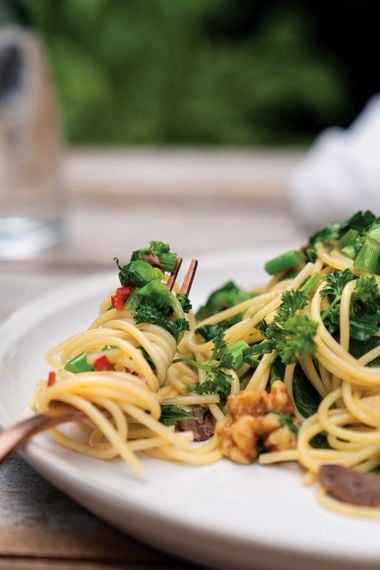
This combination of fish and walnuts is inspired by pasta dishes from Italy’s Amalfi Coast. Don’t be scared off by the anchovies. The preserved fish disappears into a rich, silken sauce infused with garlic and a hint of spice. Keeping the walnuts in large pieces adds a rich, nutty flavour and turns an economical dish into something a bit more luxurious.
Fishing for anchovies
Look for anchovy paste in tubes and anchovy fillets in oil in small jars or cans in the fridge section of your fish market or grocer. In a pinch, you can substitute a can of sardines in olive oil. Just be careful when choosing a brand, as some are quite salty. The leftover paste or jarred anchovies make for a tasty addition to any kind of sautéed greens, with or without pasta.
Sautéed Rapini with Spaghetti, Garlic, Toasted Walnuts, and Anchovies
Ingredients
- 10 oz (280 g) spaghetti
- 2 Tbsp (30 mL) anchovy oil (see tip)
- 1/2 fresh red chili pepper, finely chopped
- 4 garlic cloves, peeled but kept whole
- 1 bunch rapini, stems diced, leaves torn into small pieces
- 10 anchovy fillets in oil (see tip)
- 1/4 cup (60 mL) walnut halves
- 1/4 cup (60 mL) finely chopped fresh parsley
- 1 Tbsp (15 mL) anchovy paste (optional—see tip)
Nutrition
Per serving:
- calories324
- protein14 g
- total fat9 g
- sat. fat1 g
- total carbohydrates47 g
- sugars1 g
- fibre5 g
- sodium260 mg
Directions
01
In large pot of water, cook pasta according to package directions until al dente. Drain, reserving 1/4 cup (60 mL) cooking water.
02
While pasta cooks, in large skillet, heat oil over medium heat. Add chili pepper, garlic, and rapini stems. Cook for 1 minute. Add anchovy fillets, breaking them up so they melt into the sauce. Add walnuts, rapini leaves, half of parsley, and 1/4 cup (60 mL) pasta cooking water. Cook for 2 minutes, adding more pasta water if too dry.
03
Add drained pasta to sauce along with anchovy paste, if using, and stir to combine. Remove from heat and discard garlic (or eat it!) and garnish with remaining parsley.





